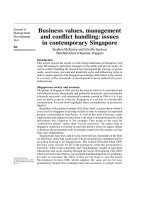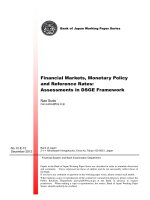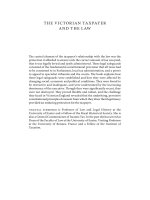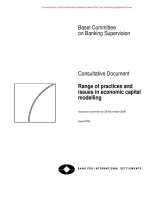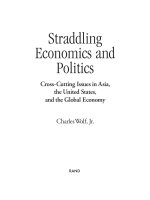vietnams competition policy and law emerging issues in implementing evfta commitments
Bạn đang xem bản rút gọn của tài liệu. Xem và tải ngay bản đầy đủ của tài liệu tại đây (1.02 MB, 100 trang )
MINISTRY OF EDUCATION AND TRAINING
FOREIGN TRADE UNIVERSITY
-------------------------
DISSERTATION
VIETNAM'S COMPETITION POLICY AND
LAW: EMERGING ISSUES IN
IMPLEMENTING EVFTA COMMITMENTS
Major: International Trade Policy and Law
PHAM THI THU HA
Hanoi – 2020
MINISTRY OF EDUCATION AND TRAINING
FOREIGN TRADE UNIVERSITY
DISSERTATION
VIETNAM'S COMPETITION POLICY AND
LAW: RECOMMENDATIONS FOR
IMPLEMENTING EVFTA COMMITMENTS
Major: International Trade Policy and Law
Full Name: PHAM THI THU HA
SUPERVISOR: Assoc.Prof. Dr. Tang Van Nghia
Hanoi – 2020
DECLARATION
I hereby declare that this master thesis is the scientific research of my
own which made on the basis of theoretical studies and under the direction
and supervision of Prof. Dr. Tang Van Nghia. The research contents and
results of this thesis is completely honest. These data and documents for
the analysis, review and evaluation were collected from various sources
which are fully listed in the reference list.
I am fully responsible for the content of this master thesis as well as
this declaration.s
rd
Hanoi, March 23 , 2020
PHAM THI THU HA
ACKNOWLEDGEMENT
One year and 6 months in Foreign Trade University has come and
gone. It is my pleasure to become a part of Master’s of International Trade
Policy and Law, Intake 6, where I had a chance to meet many interesting
and unique friends as well as many enthusiastic and world class professors
in the field of international trade and law. Thanks, Foreign Trade University
(FTU), I was able to experience a totally different academic environment
from other school, which is worth to spend my time and challenge myself.
First, I would like to express my sincere gratitude to my supervisor,
Assoc. Prof. Dr. Tang Van Nghia, Dean of Faculty of Graduate Studies of the
Foreign Trade University for his enthusiasms, patience and support from the
beginning to finishing of my master thesis. With his numerous years of
experiences and profound knowledge, he has always given me helpful
advices whenever I crashed into a dead end.
Besides this, I want to express my thankfulness to my entire classmate,
especially to become a part of my student life. Hope that everyone will be
successful and be happy in the future.
Finally, it will be missing without mentioning on the encouragement and
support of my husband, my family, and my best friends who has supported
me from the beginning until the end of this thesis. Thank you my managers
and colleagues in MPP, Vietnam Japan Universiy – for always giving me
favorable conditions for me to complete this scientific research.
Thank you, for always stay by my side and encourage me.
TABLE OF CONTENTS
ACKNOWLEDGEMENT.........................................................................4
Table of contents.....................................................................................i
LIST OF ABBREVIATIONS.......................................................................... iv
LIST OF TABLES...................................................................................v
LIST OF FIGURES................................................................................vi
LIST OF BOX(PRACTICAL CASE)......................................................vii
SUMMARY OF THESIS RESEARCH RESULTS................................viii
CHAPTER 1. INTRODUCTION.............................................................1
1.1. Research Rationale.....................................................................1
1.2. Literature Review........................................................................2
1.3. Research objectives & Research questions................................4
1.4. Scope of Research......................................................................4
1.5. Research methodology...............................................................5
1.6. Thesis outline..............................................................................5
CHAPTER 2. FUNDAMENTALS OF COMPETITION, AND
COMPETITION LAW AND POLICY...............................................................6
2.1 The concept of competition..........................................................6
2.2. Fundamentals of Competition Policy and Law............................6
2.2.1 Competition Law and Competition Policy......................................6
2.2.2 Scope and links of competition law with other policies..................7
2.2.3 Objectives of competition policy..................................................... 9
2.2.4 Contents of Competition Policy...............................................12
CHAPTER 3. INTERNATIONAL COOPERATION OF COMPETITION
POLICY........................................................................................................14
3.1 Importance and history background of international co-operation in
competition policy.....................................................................................14
3.2. Current situation of international cooperation of competition policy
................................................................................................................15
3.3. Competition related provision in FTAs.......................................16
3.3.1 Rationales for including Competition-related Provisions in FTAs 16
ii
3.3.2. Typology of Competition-related provisions in FTAs..................17
CHAPTER 4. COMPETITION POLICY IN EVFTA...............................25
4.1. Introduction to EVFTA...............................................................25
4.2 Potential macroeconomic implications of the EVFTA to Vietnam
..........................................................................................................27
4.3 Coverage of Competition policy in the EVFTA...........................27
4.4 Content of competition -related provisions in EVFTA.................29
4.4.1 Promoting competition &Adopting and maintaining competition
laws proscribe anti-competitive business conduct..........................................29
4.4.2 Procedural fairness and transparency............................................ 30
4.4.3 Regulating designated monopolies and state-owned enterprises...31
4.4.4 Regulating subsidies/state aid....................................................... 35
4.4.5 Co-operation and co-ordination on competition............................37
4.4.6Dispute settlement mechanisms for conflicts on competition........38
CHAPTER 5.OVERVIEW ON VIETNAM’s COMPETITION LAW AND
POLICY REGIME.........................................................................................40
5.1. Vietnam Competition Legislation...............................................40
5.1.1 Over view of Vietnam Competition Legistration..........................40
5.1.2Scope of application....................................................................... 42
5.1.3 Agreement on restraint of competition policy...............................45
5.1.4 Abuse of dominance...................................................................... 49
5.1.5 Economic Concentration............................................................... 52
5.1.6 Unfairs competitive practices........................................................ 60
5.1.7 Competitive authorities agencies................................................... 62
5.1.8 Sanction........................................................................................ 63
5.1.9 Leniency....................................................................................... 65
5.2 Enforcement of Competition Policy in recent years....................66
5.2.1 General assessment....................................................................... 66
5.2.2 Investigation of competition restriction cases.............................68
5.2.3 Investigation and handling of unfair competition cases..............69
5.2.4 Controlling violation of economic concentration..........................70
iii
CHAPTER 6: RECOMMENDATIONS FOR REFORMING COMPETITION
LAW AND POLICY AND ENFORCEMENT IN VIETNAM IN ACCORDANCE
WITH COMMITMENTS IN EVFTA ...................................................................... 71
6.1. Improving provisions in VietnamCompetition Law in accordance with
commitments in EVFTA .......................................................................................
6.1.1 Interpretation of term: need to be improved ...................................
71
71
6.1.2 Requirement for consistency of Vietnam legal system ..................
71
6.1.3 Improve provisions to control effectively economic concentration
73
6.1.4 Provide an incentive and transparent leniency program
as an
instrument to tackle core cartel (OECD, 2015) ................................................ 73
6.2 SOEs and competitive neutrality issues in setting a transparent
competition enviroment ........................................................................................
6.2.1 Tax neutrality ..................................................................................
74
74
6.2.2 Public procurement .........................................................................
75
6.2.3 Debt neutrality and outright subsidies ............................................
75
6.2.4 Regulatory neutrality ......................................................................
75
6.3 Maintain an independent and well resourced competition authority with
the necessary powers to effectively enforce competition law .............................. 76
6.3.1 Complete draft decree which prescribes the functions, tasks, powers
and organizational structure of the competition authority ................................ 76
6.3.2
Build financial resource to boost capacities for Vietnam’s young
competition authorities ..................................................................................... 77
6.3.3 Build human resource to boost capacities for Vietnam’s young
competition authorities ..................................................................................... 78
6.4. Strengthen cooperation between competition authories of both Parties
...............................................................................................................................
CHAPTER 7. CONCLUSION .........................................................................
81
83
LIST OF REFERENCES .................................................................................
iv
iv
LIST OF ABBREVIATIONS
Abbreviation
Meaning
Art.
Article
CPL
Competition Policy and Law
EVFTA
European Union - Vietnam Free Trade Agreement
FTAs
Free trade agreements
ICN
International Competition Network
MOIT
Ministry of Industry and Trade
NCC
National Competition Committee
OECD
Organization for Economic Cooperation and Development
RTAs
Regional Trade Agreement
SOEs
State owned enterprises
v
LIST OF TABLES
Table
Page
Table 1: Experience with International Co-operation in Enforcement, 15
by Enforcement Area (2007-2012)
Table2: Summary outline of EVFTA
27
Table 3: Brief characteristics of state-owned enterprises, enterprises
granted special rights or privileges, and designated monopolies in 33
EVFTA
Table 4: Budget for operation of competition authorities in 2016 in 78
some chosen countries
Table 5: comparison between countries in the world on the size of 80
the competition agency's personnel in 2016
vi
LIST OF FIGURES
Figure
Page
Figure 1: Four elements of competition policy must be considered to 7
promote a market-oriented economy
Figure 2: Relationship between competition law, competition policy 9
and economic development
Figure 3: Types of Competition-related Provisions in FTAs
18
Figure 4: Review Timeline between Vietnam Competition Law 48
2004& 2018
Figure 5 : Statistics of competition restriction case during 2006-2018 69
Figure 6 : Statistics on unfair compeitition case from 2009-2018 69
vii
LIST OF BOX(PRACTICAL CASE)
Box
Page
Box 1: Motor Vehicle Insurance
46
Box 2: Vinapco’s Abuse of Monopoly in the Aviation Fuel Market
51
Box 3: Vietnam Regulator Finds Grab/Uber Acquisition
Potentially Infringes Law on Competition
55
Box 4: Merger between Viettel and EVN telecom
59
Box 5: Merger between the Vietnam National Financial Switching
Joint Stock Company and Smartlink Card Services Joint Stock
60
Company
Box 6: A Nguyen Trading’s direct comparison of products
62
viii
SUMMARY OF THESIS RESEARCH RESULTS
In the past several decades, Competition Policy and Law (CPL) is an
important tool to promote fair competition and make markets work more
efficiently, particularly in the context of integration with the global economy.
From 2004, by enacted Competition Law 2004 and issues relevant policies, the
Government of Vietnam had step by step enhanced CPL to achieve effective
competition and protect customer rights. Participations in many new-generation
of RTAs and FTAs such as : CPTPP, EVFTA…, the Government of Vietnam has
to prepare an over-arching competition policy reform including the role of the
state-owned sector, anticompetitive regulations and the reform of the
competition law to ensure effectiveness for its commitments. Together with the
new 2018 Law on Competition comes into force from 1 July 2019, preparing
relevant enclosed documents, Viet Nam is on the way to address the following
emerging issues of international cooperations in the context of EVFTA
commitments. The contributions of this work are presented as follows:
Firstly, analyzing three major theoretical and conceptual frameworks:
the concept of competition; the relationship between competition policy,
competition law and economic development; and objectives of CPL. Then,
scrutinizing how CPL regulates the anti-competition context of globalization,
particularly in the formality of provisions in free trade agreements.
The systematic and theoretical analysis above is required for more
detail to assess whether Vietnam has comprehensive legislation on
competition that proscribes anti-competitive conduct, or prohibits the anticompetitive conduct by a dominant firm and provides the necessary
enforcement tools to uncover such illegal practices; (e.g. leniency programs,
investigative powers, etc.) or enough to power to take appropriate action
with respect to such conduct to ensure these objectives or not (?).
After confirming the findings of shortcomings or even loopholes in
competition policy in Vietnam, the dissertation will propose recommendations to
ix
improve an effective legal framework, an independent and well-resourced
competition authority, a healthy competition enviroment for a wellpreparation toward EVFTA.
CHAPTER 1. INTRODUCTION
1.1. Research Rationale
Competition policy today also needs to take account of the growth in trade. As
border barriers - tariffs - have decreased and market access was improved, firms
are increasingly engaged in conducting their activities across borders. Recent
theoretical developments have revealed that anti-competitive behaviors behind
borders can reduce or prevent the potential gains made in the area of market
access. CPL, if appropriately designed and effectively implemented in keeping with
the economic, social and environmental circumstances in a country, is expected to
complement other government policies in achieving sustainable and inclusive
growth and development, through the elimination and deterrence of anticompetitive
practices. In most developed countries in the world, competition policy serves as an
instrument to “encourage industrial efficiency, the optimal allocation of resources,
technical progress and the flexibility to adjust to a changing environment”.
Since the last few decades, anti-competitive practices tended to be
considered mainly as a domestic phenomenon, most facets of competition law
enforcement currently have an important international dimension. Upon that, the
dramatic rise within the range and importance of bi-lateral free trade agreements
(FTAs) recently such as has certainly developed and emerging nations alike with
a more and more well-liked popular route for promoting competition within the
international trade arena. Provisions on competition policy in FTAs and RTAs
facilitate a foreseeable, facilitative business environment. Through such
provisions, the benefits of free trade are not undermined by behind the border
public or private sector actions. A challenging problem that arises in this domain
is how to take advantage of these provisions because the difference between
legislation system, the economy of each party.
On June 30th, the EU - Vietnam has officially signed the Free Trade Agreement
(EVFTA). With 17 chapters, two protocols and numerous connected memorandums
with essential contents including trade in goods, services, investment, trade defense,
competition, state enterprises, government procurement, intellectual property, trade
2
and sustainable development, legal and institutional issues, the EVFTA is
considered a comprehensive, high-quality agreement that ensures a balance of
benefits for both Vietnam and the EU. EVFTA contains a whole chapter controlling
competition policy with detail and practical regulations. It synchronizes the anti-trust
law of member countries and elevates them to provide the most useful environment
for competition to develop in the whole organization. With the socialist-oriented
market economy, competition environment in Vietnam should bring about the best
conditions for enterprises to grow, for consumers to benefit and for social welfare to
gain. It’s necessary for Vietnam to give a crucial research on how to implement
accurately and effectively the competition-related provisions of this agreement
before the effective date (expected around June 2020). Against the context of there
has been less previous evidence for an official research on competition related
provision of EVFTA currently, the topic “ Vietnam's competition policy and law:
Emerging issues in implementing EVFTA commitments” is chosen. This thesis shall
give information about the general theory of CPL and deepens its analysis of
competition policy (competition-related provisions) in the EVFTA. After that, based
on the analysis of the current status of CPL in Vietnam, the thesis shall give several
recommendations for Vietnam in implementing these commitments effectively.
1.2. Literature Review
While there have been numerous researches in the fields of competition law
and policy, there are not many researches focusing on competition policy in the
EVFTA. The reason is that EVFTA only finalized its negotiations in July of last year.
However, researches on international competition law and policy as well as
competition policy in Vietnam are a really immense collection. This section shall
make a general assessment of several typical and outstanding researches.
First of all, Competition policy theory and practice by Massi Motta avital book
which presents milestone concepts and answer on how competition policy and law
could foster a significant role in achieving sustainable and comprehensive growth
and development. It is a book coping with both the theory and practice of
competition policy. This is an extremely important textbook in the economics of
3
lecturers, students, economists and lawyers. It draws on the literature of
industrial organizations, and on original analyses, to disclose the doubtless
effects that firms’ practices have on the welfare and formulate policy
recommendations, which are of sensible use for antitrust authorities. The
interaction between theory and practice is one amongst the fundamental
features of the book, that contains various references to competition policy
cases (mostly from the EU and the US) and a few fully developed case studies.
Secondly, research on International Co-operation in Competition Law
Enforcement of group experts or international economic organization such as
OECD:
Challenges
of
International
Co-Operation
in
CompetitionLaw
Enforcement International Aspects of Competition Law by Francisco Gonzalez
de Cassio; Competition Provisions in Regional Trade Agreements: How to
Assure Development Gains (UN); Competition Policy in The New Trade Order:
Strengthening International Cooperation and Rules (EC)…play a significant role
in provides up-to-date analyses of practical competition law and policy at the
global level. The OECD’s Competition Committee has played a significant role in
shaping the framework for international co-operation between competition law
enforcement authorities and had progressed “investigative assistance” as a tool
to strengthen enforcement in one jurisdiction with the help of enforcers in other
jurisdictions. Most of the 35 OECD members are from Europe and 4 others from
the Americas. Therefore, this paper has also referred to many reports and Art of
expert groups from OECD.
To review CPL of Vietnam, there are so many papers been referred, one of
them is a report on Viet Nam Competition Law by Mayer Brown in 2019. The report
as provided evidence for the improvement of Competition Law 2008 compare to
Competition Law 2004, which detail demonstrates highlights of provisions.
Last but not least, The Brief Review Report of Vietnam Competition Legislation
(2012) by VCA and Peer Reviews of Competition Law and Policy in VIETNAM (2018)
by OECD are two more specialized type of researches in this field. In the light of
reported issues emerging from enforcing competition law of Vietnam, it is
4
conceivable that it is necessary for Vietnam to rebuild a set of provisions in
the Competition Law of Vietnam in conformity with the context of the
Vietnamese economy in the globalization era.
1.3. Research objectives & Research questions
The dissertation, for the first goal, clarifies the issues of international
cooperation competition policy by analyzing and interpreting the competitionrelated provisions in EVFTA and on the other hand, analyzing the practices of
implementation and enforcement of Vietnam Competition Law. After defining the
problem, the dissertation gives recommendations for implementing EVFTA’s
commitment in terms of competition policy in the most effective way.
The objectives of the dissertation are derived from the research
questions as follows:
- What are the characteristics of international CPL?
- What are the important issues in international cooperation of CPL?
- What are the contents of the competition policy in the EVFTA?
- How about the practices of CPL in Vietnam?
- How can Vietnam’s CPL be improved towards commitments in the EVFTA?
1.4. Scope of Research
Regarding the content of the dissertation, it focuses on the real situation of
competition policy and la w of Vietnam and competition policy (competitionrelated provisions) in the EVFTA. The scope of this thesis is as follows:
For geographical scope, the research is intended to conduct a depth
practical view concerning commitments of Vietnam to EU regading
competition law and policy in Vietnam.
For time scope, the research focuses its analysis and synthesis situation of
enforcement of Vietnam competition policy from 2004-2018 and from that
proposes some recommendations to comply with the commitments in EVFTA.
5
1.5. Research methodology
During the research process of this thesis, the author has combined
different research methods as follows:
- Theoretical research methods:
+ Analysis and synthesis of theory
+ Historical research method
+ Modeling
- Practical research methods:
+ Comparative legal research
+ Review of experience
+ Case studies, secondary date analysis
1.6. Thesis outline
Chapter 1: Introduction
Chapter 2: Fundamentals and Issues Rising in International Cooperation
of Competition Law and Policy
Chapter 3: Aspects in International Cooperation of Competition Policy
Chapter 4: Competition Policy in EVFTA
Chapter 5: Review on Vietnam’s Competition Law and Policy Regime
Chapter 6: Conclusion
6
CHAPTER 2. FUNDAMENTALS OF COMPETITION, AND
COMPETITION LAW AND POLICY
2.1 The concept of competition
The conceptual clarity is particularly important when one keeps in mind the
purposes of researching. There are varied different views of competition. According
to the Cambridge dictionary, competition is a situation in which someone is trying to
win something or be more successful than someone else. However, in economics,
competition means a struggle for superiority- a striving for the custom and business
of people in the market place (Bailey (2009). At the heart of the concept of
competition stands the freedom to compete. This means that market operators
must have the freedom to compete for a process of competition. In practical terms,
this means that a free-market economy must exist: competition is the flywheel of a
free economy (Dabbah, 2010). Competition incessantly evolves and is an extremely
dynamic process, which is conditioned by wider developments and circumstances
both within and outside the marketplace. One of the most outstanding ways in
which competition has evolved over the years has been in its becoming a ‘global’
concept. This has been expedited by the ‘adoption’ of the concept by important
international organizations, including the Organization for Economic Cooperation
and Development (OECD), the United Nations Conference on Trade and
Development (UNCTAD), the World Bank, the International Monetary Fund (IMF)
and to a large extent the World Trade Organization (WTO), as well as by the
process of market globalization and the process of trade liberalization, which has
been sweeping through different countries around the world (Dabbah, 2010).
2.2. Fundamentals of Competition Policy and Law
2.2.1 Competition Law and Competition Policy
Being one of the essence policies for economic development, competition
policy contributes to developing competition legislation of every country.
Competition policy orientates contents of competition law and in conjunction with
competition law, creating a legal environment on the competition. The final purpose
7
of competition policy is economic growth and consumer welfare through their
rights to choose which appropriated on the market they want.
In particular, the conception of competition policy is considerably wider than
that of competition law. As stated in Maher M. Dabbah in International and
Comparative Competition Law, “competition law is a body of legal rules and
standards which aim at protecting the process of competition: dealing with market
imperfections and restoring desirable competitive conditions in the market”.
Competition policy is concerned with the formulation of competition law and its
enforcement. In particular, competition law is an element of competition policy:
Competition
law
Trade
liberalization
Deregulation
Privatization
Figure 1: Four elements of competition policy must be considered to
promote a market-oriented economy
2.2.2 Scope and links of competition law with other policies
Competition policy is often considered as a collection of public policy tools
promoting efficient allocation of resources. Above, we have defined competition
policy in a very broad sense; conversely, competition law is considered a narrow set
of rules covering the behavior of companies. Indeed, the discrepancy between
competition policy and the application of competition law is, in part, based on the
scope of the law and the authority of the competition law. Competition laws cannot
be isolated. The law itself can never guarantee that a market will function effectively
without a range of other government policies that adhere to basic market principles.
8
Trade policy, industrial policy, privatization, deregulation, regional policy and social
policy all need to be enforced in a manner compatible with the market mechanism
for an economy to function effectively. For example, US laws were implemented in a
more lenient way in the time of the Great Depression with the view that some price
agreement would help firms to avoid bankruptcy, thus easing social tensions
caused by unemployment. The political reasons might also justify some competition
policy positions. When the Allied Fores decided to break up industrial groups in
Germany and Japan, the reason for that is the danger of having an economic
concentration of power being used for political purposes. Also, the environmental
reason might also be taken in to account in the enforcement of Competition law.
Countries that aim to support national champion, or breaking up the foreign
champion, have also use competition policies as the instruments. Lax competition
policies in some countries can sometimes be defined by the willingness of a
national government to allow domestic firms to bigger and more competitive powerin the belief that it will help their firms more successful vis-à-vis foreign rivals. In
international trades, competition policies also are used instruments to prove that
there has been dumping by foreign firms, that are being penalized even when they
are simply more efficient (MOTTA, 2004).
9
Figure 2: Relationship between competition law, competition
policy and economic development
To expand the above idea, which is competition laws has the belonged to field
of economic law which regulates the anti-competition acts. It carried characteristic
of public law and private law, that is derived from principles of free for make
covenants; free of trading in Civil Law and Commercial and simultaneously,
encompasses a system that regulates authority’s intervene to economic relation of
public law (Nghia, 2013). First, the relationship between Competition Law and Civil
Code is proved by most provisions of Competition Law and is influenced by
principles in Civil Law. Eg: Rule of unfair competition is actually the development of
principles of respect for goodwill in civil transaction and compensation for damages
( contract or tort). Commercial Law also stuck with Competition Law in a close
relationship, due to Commercial law regulates commercial activities of traders, while
competition law governs competition aspects of those activities. For examples, for
regulations in chapter IV, section 1 in Viet Nam Commercial 2005; Competition Law
had added provisions which prohibited “Providing false or misleading information to
customers about the enterprise or products, services, sale promotion programs,
transaction conditions related to the products or services provided by the enterprise
i
to attract customers of competitors ” (Nghia, 2013). In addition, the Law on
Enterprises stipulates the establishment, management organization and operation
of limited liability companies, joint-stock companies, partnerships and private
enterprises of all economic sectors, and regulations on public groups- the object
that creates competitive activities in the market. Then, it is necessary to have a
legal framework to regulate the competitive activities of enterprises to ensure that
there is no situation between enterprises compete with negative tactics or break the
competition. Competition law is a tool to create and ensure a fair and healthy
business environment for all business entities in the market.
2.2.3 Objectives of competition policy
The objectives of competition policy have been long debated among
economists, legal practitioners and policymakers. While many objectives have been
10
ascribed to competition policy during the past hundred years, certain major themes
stand out. The most common of these objectives cited is the maintenance of the
competitive process or of free competition, or the protection or promotion of effective
competition. Associated objectives are freedom to trade, freedom of choice, and
access to markets. In some countries, such as Germany, freedom of individual action is
viewed as the economic equivalent of a more democratic constitutional system. In
France emphasis is placed on competition policy as a means of securing economic
freedom, that is, freedom of competition" (World Bank-OECD 1997, p2). In general,
almost studies agree three fundamental objectives as following:
- Economic welfare
- Economic efficient (allocative, productive and dynamic)
- Establishment of economic competitiveness regime
Firstly, economic welfare is the standard concept used in economics to measure
how well an industry performs. It is a measure that cumulative the welfare (or surplus)
of different groups in the economy. Welfare is given by total surplus in each given
industry, which is the sum of consumer surplus and producer surplus. A consumer
surplus occurs when the price that consumers pay for a product or service is less than
the price they're willing to pay. Producer surplus is the additional private benefit to
producers, in terms of profit, gained when the price they receive in the market is more
than the minimum they would be prepared to supply for. However, when the price
increases, the increase in profits made by the firms does not compensate for the
reduction in the consumer surplus (MOTTA, 2004). The loss of welfare so-called
deadweight loss. For example, in a market for bread where the cost of each bread is
$0.10, the demand will decrease from high demand for less expensive bread to zero
demand for bread at $1.10. In a perfectly competitive market, the seller would charge
$0.10 per bread and every consumer whose marginal benefit exceeds the $0.10 would
have bread. However, if one seller has a monopoly on the bread they will charge
whatever price will bring the largest profit. If they charge $0.40 per bread, every party
who has less than $0.40 of marginal benefit will
11
be excluded. When equilibrium is not achieved, parties who would have
willingly entered the market are excluded due to the non-market price.
Another commonly stated competition law objective is economic efficiency.
Economic efficiency refers to the effective use and allocation of the economy’s
resources. When goods and services are produced and distributed to consumers
who value them the most, the allocative efficiency is achieved. Firms are often put
under pressure on producing at the lowest possible cost so as to have a competitive
advantage. This will benefit the consumers. In the event of no market entry barriers,
even when a monopoly, firms are subject to quote a competitive price (relatively low
price) for product and service, because if they set a high price, potential competition
subjects shall have chances to access the market (Tang Van Nghia, 2013, p.55). This is
also a motivation for firms to undertake research and development to meet diversified
customer needs. As a result, competition has a tendency to bring about enhanced
efficiency in both static and dynamic sense. Allocative efficiency has also been
defined technically as marginal cost pricing. Productive efficiency is related to
cost minimization. Both allocative efficiency and productive efficiency are
considered to be static efficiencies. Static efficiencies are ‘one-off’ gains from
improvements in resource allocation given that no change in technology takes
place. To some extent, these concepts are associated with general equilibrium
theory, which is essentially static in nature. Both social welfare and total welfare
are maximized in perfectly competitive markets. Thus, for such markets – at
least theoretically – efficiency coincides with welfare maximization.
Finally, competition policy introduces a “level-playing field” for all market
players that will help markets to be competitive. Competition policy not only is the
basis of legal framework for competition activities in one economy but also establish
competition law and policy enforcement institutions. This, in turn, heightens
enterprises’ awareness of competition law compliance, protects rights and benefits of
consumers and fosters their sense of self-protection against risks of the drawbacks of
competition. Therefore, competition in the market is always kept in control and in
line with the whole benefit of the society
12
2.2.4 Contents of Competition Policy
For the purpose of ensuring the presence of competition relationships and
economic development, governmental competition policy is often established in line
with economic conditions and often comprises of contents as follows (Tang Van
Nghia, 2013, p.57):
-
Assuring the firms’ right of unlimited access and non-discrimination in all
markets. In case there is existence of market entry barriers, competition is
restrained and market power is abused.
-
Competition policy illustrates vividly the objectives of regulating competition
relationships of the whole economy. The condition of this regulation objective
is that economic system should be built based on suitable political-legal
regime. Competition policy shall explicitly show the free rights of entry or
exit from the market, the right of reforming the forms of business organization
and the right of free competition of business subjects.
-
Competition policy, on one hand, shall maintain the fair and equal competition
environment; on the other hand, shall oppose to anti-competitive business
practices due to abuse of market power, monopoly or anti-competitive
mergers from any subjects within or out of its nations.
-
Having full of measures to ensure an effective implementation of competition
law and policy. Enforcement institutions of Competition Law shall have
favorable capacity and authorization in its specialization. Meanwhile, subjects
on the market shall be self-conscious and shall have appropriate actions with
regulations of competition law and policy.
-
Having proper, capable and competent institutions to enforce competition law
in practice in order for all subjects on the market to strictly obey competition
law. Therefore, there should have an independent and competent competition
regulatory body to solve competition issues. Competition policy makes sure
of cooperation mechanism of enforcement competition law bodies and
supervises activities of them.
